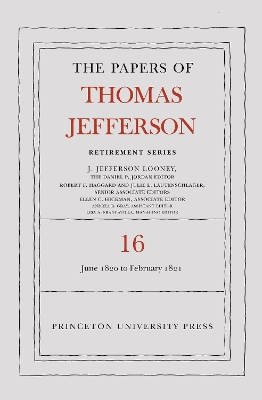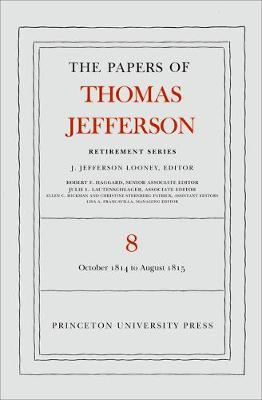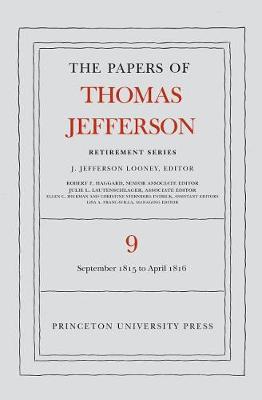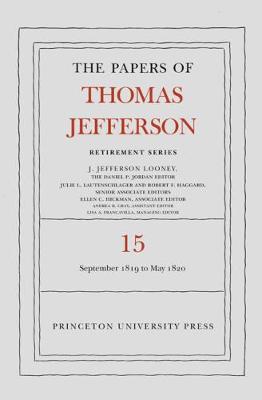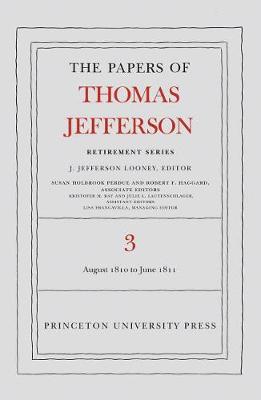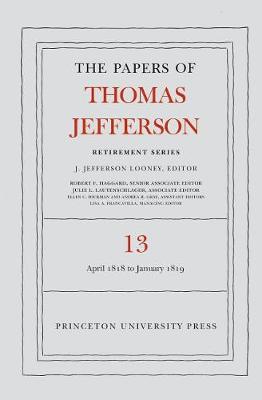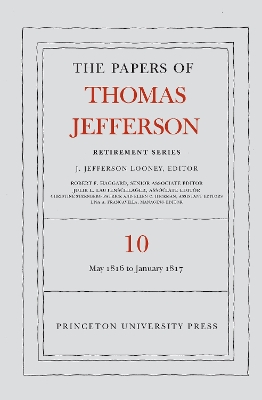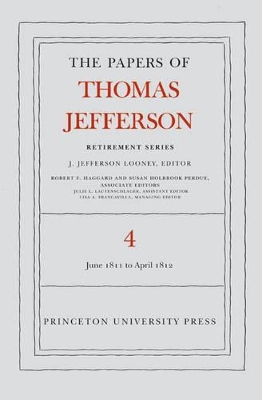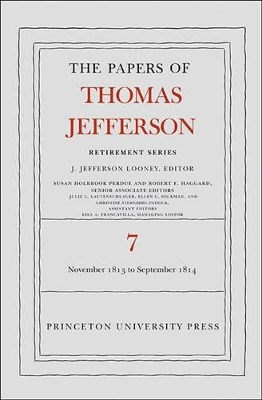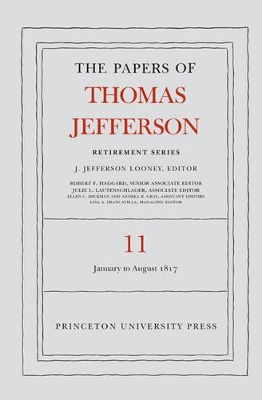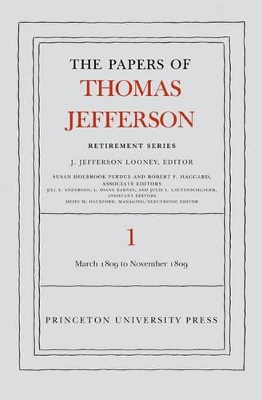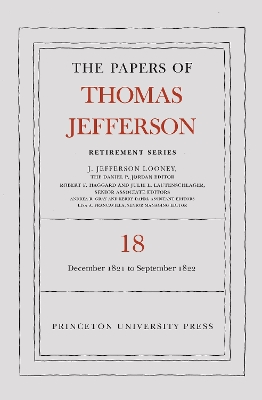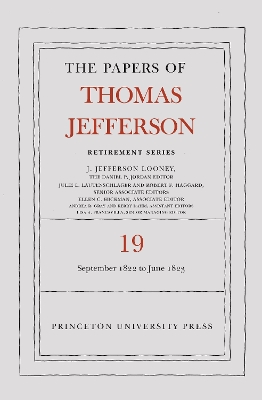Papers of Thomas Jefferson: Retirement
1 primary work • 18 total works
Book 16
The Papers of Thomas Jefferson: Retirement Series, Volume 16
by Thomas Jefferson
The Papers of Thomas Jefferson, Retirement Series, Volume 8
by Thomas Jefferson
Finally, although death takes his nephew Peter Carr and brother Randolph Jefferson, the marriage of his grandson Thomas Jefferson Randolph is a continuing source of great happiness.
The Papers of Thomas Jefferson, Retirement Series, Volume 9
by Thomas Jefferson
Despite a report of his death, Jefferson continues to enjoy perfect health.
The Papers of Thomas Jefferson: Retirement Series, Volume 14
by Thomas Jefferson
The 637 documents in this volume span 1 February to 31 August 1819. As a founding member of the University of Virginia Board of Visitors, Jefferson helps to obtain builders for the infant institution, responds to those seeking professorships, and orchestrates the establishment of a classical preparatory school in Charlottesville. In a letter to Vine Utley, Jefferson details his daily regimen of a largely vegetarian diet, bathing his feet in cold water each morning, and horseback riding. Continuing to indulge his wide-ranging intellectual interests, Jefferson receives publications on the proper pronunciation of Greek and discusses the subject himself in a letter to John Adams. Jefferson also experiences worrying and painful events, including hailstorm damage at his Poplar Forest estate, a fire in the North Pavilion at Monticello, the illness of his slave Burwell Colbert, and a fracas in which Jefferson's grandson-in-law Charles Bankhead stabs Jefferson's grandson Thomas Jefferson Randolph on court day in Charlottesville. Worst of all, Jefferson's financial problems greatly increase when the bankruptcy of his friend Wilson Cary Nicholas leaves Jefferson responsible for $20,000 in notes he had endorsed for Nicholas.
The Papers of Thomas Jefferson: Retirement Series, Volume 12
by Thomas Jefferson
He attends a Masonic cornerstone laying ceremony for the nascent Central College's first pavilion early in October 1817 and is greatly pleased by the passage on 21 February 1818 of a law establishing a commission to plan a new state university, raising his hopes that Central College might soon become the University of Virginia.
The Papers of Thomas Jefferson, Retirement Series, Volume 5
by Thomas Jefferson
Despite the conflict, Jefferson graciously writes a letter of introduction for Scott's son. Jefferson remains accessible to the public, receives anonymous letters urging him to convert to Christianity, and settles a wager for one correspondent who asks if Jefferson ever met the British king. Jefferson gloomily observes that "the hand of age is upon me" and complains that his faculties are failing. He still has thirteen years to live.
The Papers of Thomas Jefferson, Retirement Series, Volume 2
by Thomas Jefferson
Highlights include a long list of books on agriculture that Jefferson probably compiled to guide the Library of Congress in its purchases; descriptions of inventions by Robert Fulton and more obscure figures such as the New Orleans engineer Godefroi Du Jareau; Jefferson's draft letter criticizing the Quakers as unpatriotic, much of which he later deleted; the letter in which he ordered a set of silver tumblers that have become known as the Jefferson Cups; and an important treatise on taxation by the distinguished French political economist Pierre Samuel Du Pont de Nemours, published here for the first time.
The Papers of Thomas Jefferson: Retirement Series, Volume 15
by Thomas Jefferson
The Papers of Thomas Jefferson, Retirement Series, Volume 3
by Thomas Jefferson
Documents on slaves and slavery include discussions of schemes for colonizing freed slaves in Africa, information on the medical condition of some of Jefferson's slaves, and an account of a visit to Monticello with a distinctly unflattering portrayal of the ex-president's standing in the community and his relations with his slaves.
The Papers of Thomas Jefferson: Retirement Series, Volume 13
by Thomas Jefferson
Abigail Adams dies, and Jefferson assures John Adams that their own demise will result in "an ecstatic meeting with the friends we have loved & lost and whom we shall still love and never lose again."
The Papers of Thomas Jefferson: Retirement Series, Volume 10
by Thomas Jefferson
Jefferson and Francis Adrian Van der Kemp trade letters about Jesus's life and teachings, and after the ailing Charles Thomson circulates the mistaken idea that Jefferson has converted to Christianity, correspondents question him about his spiritual beliefs.
The Papers of Thomas Jefferson, Retirement Series, Volume 4
by Thomas Jefferson
Finally, and perhaps of greatest importance to posterity, in January 1812 correspondence resumes between Jefferson and his old friend John Adams, after a long hiatus resulting from their rivalry for the presidency in 1800.
The Papers of Thomas Jefferson, Retirement Series, Volume 6
by Thomas Jefferson
Finally, this volume records the most intense period of correspondence between Jefferson and John Adams during their retirement. In an exchange of thirty-one letters, the two men reveal their hopes and fears for the nation.
The Papers of Thomas Jefferson, Retirement Series, Volume 7
by Thomas Jefferson
Jefferson's wide-ranging correspondence includes a temperate response to a lengthy letter from Miles King urging the retired president to reflect on his personal religion, and a diplomatic but noncommittal reply to a proposal by Edward Coles that the author of the Declaration of Independence employ his prestige to help abolish slavery. Having learned of the British destruction late in August 1814 of the public buildings in Washington, Jefferson offers his massive book collection as a replacement for the Library of Congress. The nucleus for one of the world's great public libraries is formed early in 1815 when the nation purchases Jefferson's 6,707 volumes.
The Papers of Thomas Jefferson: Retirement Series, Volume 11
by Thomas Jefferson
Even though Jefferson answers his voluminous correspondence selectively, he still chafes under the burden.
The Papers of Thomas Jefferson, Retirement Series, Volume 1
by Thomas Jefferson
The volume's highlights include first-hand accounts of Jefferson's demeanor at his successor's inauguration and one of the most detailed descriptions of life at Monticello by a visitor; Jefferson's recommendations on book purchases to a literary club and a teacher; chemical analyses of tobacco by a French scientist that first isolated nicotine; the earliest descriptions of the death of Meriwether Lewis; one of Jefferson's most eloquent calls for religious tolerance; and his modest assessment of the value of his writings in reply to a printer interested in publishing them.
The Papers of Thomas Jefferson, Retirement Series, Volume 18
by Thomas Jefferson
A new definitive volume of the retirement papers of Thomas Jefferson
This volume’s 627 documents feature a vast assortment of topics. Jefferson writes of his dread of “a doting old age.” He inserts an anonymous note in the Richmond Enquirer denying that he has endorsed a candidate for the next presidential election, and he publishes two letters in that newspaper under his own name to refute a Federalist claim that he once benefited by overcharging the United States Treasury. Jefferson does not reply to unsolicited letters seeking his opinion on constitutional matters, judicial review, and a call for universal white male suffrage in Virginia. Fearing that it would set a dangerous precedent, he declines appointment as patron of a new society “for the civilisation of the Indians.” Jefferson is also asked to comment on proposed improvements to stoves, lighthouses, telescopes, and navigable balloons. Citing his advanced age and stiffened wrist, he avoids detailed replies and allows his complaint to John Adams about the volume of incoming correspondence to be leaked to the press in hopes that strangers will stop deluging them both with letters. Jefferson approves of the growth of Unitarianism and predicts that “there is not a young man now living in the US. who will not die an Unitarian.”
The Papers of Thomas Jefferson, Retirement Series, Volume 19
by Thomas Jefferson
A definitive new volume of the retirement papers of Thomas Jefferson
This volume’s 601 documents show Jefferson dealing with various challenges. He is injured in a fall at Monticello, and his arm is still in a sling months later when he narrowly escapes drowning during a solitary horseback ride. Jefferson obtains temporary financial relief by transferring a $20,000 debt from the Bank of the United States to the College of William and Mary.
Aided by a review of expenditures by the University of Virginia that uncovers no serious discrepancies, Jefferson and the Board of Visitors obtain a further $60,000 loan that permits construction to begin on the Rotunda.
Jefferson drafts but apparently does not send John Adams a revealing letter on religion. He exchanges long letters discussing the Supreme Court with Justice William Johnson, and he writes to friends about France’s 1823 invasion of Spain. Jefferson also helps prepare a list of recommended books for the Albemarle Library Society.
In November 1822, Jefferson’s grandson Francis Eppes marries Mary Elizabeth Randolph. He gives the newlyweds his mansion at Poplar Forest and visits it for the last time the following May. In a letter to James Monroe, Jefferson writes and then cancels “my race is near it’s term, and not nearer, I assure you, than I wish.”
